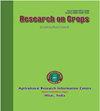作物种植模式和粪肥类型对印度尼西亚西爪哇Jatinangor地区萨班木(Caesalpinia Sappan L.)生长的影响
Q3 Agricultural and Biological Sciences
引用次数: 0
摘要
萨班木是印度尼西亚的药用植物之一。考虑到萨班木植物在保健和工业领域的潜力,需要采用特殊的栽培技术,以确保萨班木植物能够以较大的茎径生长。通过适当的种植距离可以获得较大的茎径。适当的种植距离要求土地具有足够的有机物含量。本研究旨在确定最佳种植距离和适当的有机材料类型,以培育出大茎直径的萨班木植物。采用的实验设计是分割小区设计,以种植距离(J)为主小区,有机肥(P)为副小区。种植距离因子水平为 J1 = 1m x 1m,J2 = 2m x 2m cm,J3 = 3m x 3m。有机肥因素水平为 P1 = 牛粪肥料、P2 = 鸡粪肥料和 P3 = 羊粪肥料。结果表明,在 3 MAP(种植后数月)时,种植距离处理和使用粪肥对萨班木植株的茎径和土壤酸碱度参数有交互作用。种植距离处理对结果有独立影响,1 米 x 1 米的种植距离对植株高度和茎秆直径的影响最佳。总的来说,施用不同类型的肥料对萨班木植物的生长没有显著影响。本文章由计算机程序翻译,如有差异,请以英文原文为准。
Effect of crop pattern and types of manure on the growth of Sappan wood (Caesalpinia Sappan L.) in Jatinangor, West Java, Indonesia
Sappan wood plants are one of the medicinal plants in Indonesia. Considering the potential of Sappan wood plants in the health and industrial sectors, special cultivation techniques are required to ensure that Sappan wood plants can grow with a large stem diameter. A large stem diameter can be achieved by using the appropriate planting distance. The right planting distance requires land with sufficient organic content. This research aims to determine the optimum planting distance and the appropriate type of organic material to produce Sappan wood plants with a large diameter. The experimental design used was a Split Plot Design, with planting distance (J) as the main plot and organic fertilizer (P) as the sub-plot. The planting distance factor levels were J1 = 1m x 1m, J2 = 2mx2m cm, J3 = 3m x3m. The organic fertilizer factor levels were P1 = Cow Manure Fertilizer, P2 = Chicken Manure Fertilizer, and P3 = Sheep Manure Fertilizer. The results showed an interaction between the planting distance treatment and the use of manure fertilizer on the parameters of stem diameter and soil pH of Sappan wood plants at 3 MAP (months after planting). The planting distance treatment independently influenced the results, with a 1m x 1m planting distance providing the best results for plant height and stem diameter. In general, the application of different types of manure did not significantly affect the growth of Sappan wood plants.
求助全文
通过发布文献求助,成功后即可免费获取论文全文。
去求助
来源期刊

Research on Crops
Agricultural and Biological Sciences-Soil Science
CiteScore
1.50
自引率
0.00%
发文量
93
审稿时长
1 months
期刊介绍:
The Research on Crops is a peer-reviewed journal publishing original research papers, review articles and short communications in English on all basic and applied aspects of crop sciences, agricultural water management, agro-climatology, agroforestry, agronomy, crop production, crop protection, cropping systems, food science & technology, genetics & plant breeding, horticulture, plant & soil science, plant biotechnology, plant nutrition, post-harvest management of crops, seed science, soil management & tillage, vegetables, weed science, agricultural engineering, agri-business, agricultural economics and extension, etc. The aim of the journal is to provide a forum for the scientific community to publish their latest research findings.
The manuscripts submitted for publication should not contain data older than 4 years on the date of submission.
The articles submitted for publication in this journal should not be submitted elsewhere simultaneously for publication in another journal. These should not carry any copyright material without prior permission of copyright holder.
The articles should present a complete picture of the investigation made and should not be split into parts.
There is no prescribed limit regarding the number of pages in case of full-length articles. However, the authors are advised to keep the length of their articles from 4 to 10 full printed pages of the journal.
The articles should be divided into the sub-sections: ABSTRACT, INTRODUCTION, MATERIALS AND METHODS, RESULTS AND DISCUSSION, CONCLUSIONS, and REFERENCES. Tables and figures should be appended separately at the end.
 求助内容:
求助内容: 应助结果提醒方式:
应助结果提醒方式:


